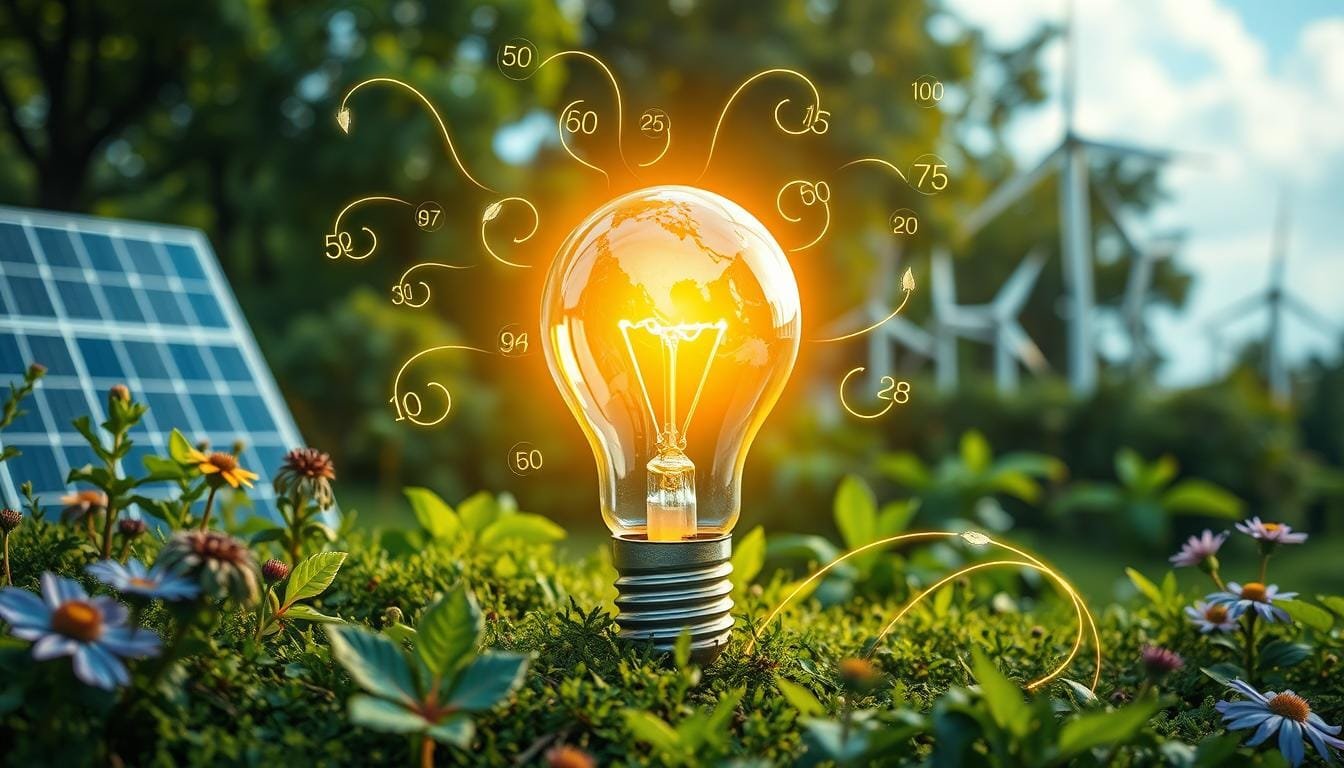Imagine saving the power of an entire power plant without building a new one. This is what negawatts are all about. They change how we think about making and using energy.
A negawatt is a unit of energy saved. It was first thought of by Amory Lovins in 1985. It’s not just about cutting down energy use. It’s about seeing saved energy as valuable, just like the energy we make.
This idea changes how we see energy use. Instead of just making more electricity, negawatts focus on using less. This could mean we don’t need to build more power plants. It also helps the environment.
Key Takeaways
- Negawatts represent saved energy as a measurable resource
- Energy conservation becomes a strategic alternative to power generation
- Developed to challenge traditional energy production models
- Provides economic and environmental benefits
- Encourages innovative approaches to energy management
Understanding the Negawatt Concept
The negawatt is a new way to think about energy. It’s about saving energy, not just using it. It’s a unit of energy saved through smart ways.
Negawatts are a smart way to cut down on energy use. They offer a solution to today’s energy problems. They show that not using energy is just as valuable as making it.
Origins and Etymology
The term “negawatt” started with a typo in a Colorado Public Utilities Commission document. This mistake turned into a big idea in energy management.
The Role in Energy Conservation
- One negawatt means one kilowatt of electricity saved
- It pushes for energy-saving actions
- It shows clear results in cutting energy use
Basic Principles of Negawatt Power
The idea of negawatt power is simple: saved energy is as valuable as generated energy. It’s cheaper to save energy than to make more.
| Energy Saving Method | Potential Negawatt Generation |
|---|---|
| LED Lighting Transition | Up to 85% energy reduction per bulb |
| Smart Thermostat Usage | 10-20% peak demand reduction |
| Home Insulation Improvement | 20-30% heating/cooling energy savings |
“A kilowatt saved is more valuable than a kilowatt generated” – Energy Conservation Principle
Now, with smart home tech, saving energy is easy. It turns energy saving into a chance to help the planet.
Negawatt Definition and Core Components
The negawatt concept is a smart way to cut down energy use. It uses new ways to save energy. Amory Lovins says it’s about using less energy by doing more with less.
- Energy saved with new tech
- Less energy use without losing productivity
- Smart ways to save energy
“Efficiency is the cleanest and cheapest energy resource.” – Amory Lovins
Negawatt power is about smart energy use and finding new ways to save. Companies can save a lot by looking at how they use energy.
| Negawatt Component | Description | Potential Impact |
|---|---|---|
| Technological Intervention | Smart meters and monitoring systems | 10-30% energy savings |
| Behavioral Changes | Efficiency awareness and training | 5-15% consumption reduction |
| Infrastructure Optimization | Energy-efficient equipment upgrades | 20-50% possible savings |
By 2050, experts think we could cut energy demand by up to 50%. This shows how powerful negawatt strategies can be for managing energy.
The History of Negawatts and Amory Lovins
The negawatt revolution started with a visionary named Amory Lovins. He changed how we see energy efficiency. Lovins introduced a new way to think about energy use.
In 1985, Lovins wrote a key article in Public Utilities Fortnightly. He said utility companies could make money by selling efficiency instead of electricity.
Development of the Concept
Lovins came up with the idea of negawatts. It means energy saved through being more efficient. His idea focused on:
- Reducing energy use
- Supporting sustainable energy
- Changing how utilities work
Impact on Energy Policy
“The cheapest energy is the energy you don’t use.” – Amory Lovins
The negawatt revolution grew thanks to smart policy changes. Important moments include:
| Year | Policy Achievement | Impact |
|---|---|---|
| 2007 | California Decoupling System | First state to link utility profits with efficiency |
| 2011 | Expanded Decoupling | 27 states followed with efficiency-linked models |
Evolution of the Negawatt Revolution
Lovins’ Rocky Mountain Institute pushed for energy efficiency research. The group showed that investing in negawatts could lead to big wins. By 2019, energy efficiency spending was set to grow four times, proving Lovins right.
His own home shows what negawatts are all about. It uses just 1% of the usual heating energy and cuts electricity use by 90%.
How Negawatts Differ from Traditional Energy Savings

Negawatts are a new way to save energy that’s different from old methods. They focus on using energy wisely, not just cutting back. This is done through new technologies and changes in how we act.
“The smartest energy is the energy you never use” – Amory Lovins
Negawatts and old ways of saving energy are not the same. Old methods ask us to turn off lights. Negawatts aim to make systems more efficient.
- Negawatts measure saved energy as a quantifiable resource
- Focuses on technological solutions, not just cutting back
- Changes how we use energy with smart systems
Here are some examples of negawatt strategies:
- Smart thermostats that adjust heating and cooling
- Advanced energy management systems
- High-efficiency appliances
| Traditional Conservation | Negawatt Approach |
|---|---|
| Manual behavior changes | Automated efficiency systems |
| Temporary reductions | Sustained energy optimization |
| Individual actions | Comprehensive technological solutions |
Indiana shows how negawatts work. The state saved 40% more energy with smart plans. This shows the power of smart energy use.
Negawatts make saving energy an active, smart choice. They turn saving energy into a goal, not just a habit.
The Economics of Negawatt Power
Negawatt power is a new way to think about using electricity. It focuses on saving energy, which helps businesses and people save money. This approach creates financial benefits.
Negawatt power’s value comes from its unique way of measuring saved energy. It uses a cost-effectiveness analysis. This means saving energy directly equals making money.
Cost-Effectiveness Analysis
Cost-effectiveness analysis is key for negawatt power. It shows how much money is saved by using less energy. The main points are:
- Figuring out how much energy is saved in dollars per kilowatt-hour
- Comparing negawatt investments to traditional energy sources
- Looking at long-term financial gains
Financial Benefits for Consumers
People can gain a lot from negawatt strategies:
- Getting tax breaks for energy-saving upgrades
- Lowering utility bills
- Less money spent on keeping energy-efficient tech running
Market Value Assessment
| Negawatt Market Indicator | Economic Impact |
|---|---|
| Energy Savings Possible | Up to 50% less energy use |
| Investment Payback Time | Usually 1-2 years |
| Annual Savings | About $3.50 per square foot |
“The cheapest energy is the energy you don’t use” – Amory Lovins
Green energy and saving energy are changing the economy. Negawatt power is becoming more appealing to smart investors and companies.
Implementation Strategies for Negawatt Generation
To cut down energy use, we need smart plans in different areas. Companies can make big changes by using energy wisely. This means finding ways to save energy through negawatt generation.
Here are some main steps to save energy:
- Do detailed energy checks
- Find out which machines use a lot of energy
- Use smart systems to watch energy use
- Switch to newer, energy-saving tech
“A megawatt saved is a megawatt generated” – Federal Energy Regulatory Commission
Industrial places have big chances to use energy better. Pumps are a big area for savings, as they use a lot of energy. In fact, most of a pump’s cost comes from energy use.
| Sector | Potential Energy Savings | Implementation Complexity |
|---|---|---|
| Manufacturing | 15-30% | Medium |
| Chemical Processing | 20-40% | High |
| Utilities | 10-25% | Low |
Starting energy-saving projects is often the cheapest and quickest way to cut energy use. Companies can save money every month by focusing on negawatt generation.
Government Policies and Negawatt Initiatives
The United States is leading in energy-saving efforts through government policies. These efforts focus on negawatt power plants. They are key to cutting down energy use and building a sustainable future.
Federal programs have been key in spreading negawatt efforts across the country. The American Recovery Act gave a big boost to energy efficiency:
- $831 billion total act value
- Over 11% dedicated to energy spending
- $32 billion for energy efficiency projects
State-Level Implementation Strategies
State governments have also played a big role in saving energy. California was a leader, starting programs that reward companies for saving energy.
By 2011, the results were impressive:
- 27 states adopted gas or electric decoupling mechanisms
- Potential for quadrupling energy efficiency program spending between 2009-2019
- A proposed $500 billion investment could generate $1.2 trillion in future savings
International Adoption
The negawatt idea is catching on worldwide. Countries see its value in solving energy problems. Innovative approaches to energy conservation are being tried globally, showing the world’s interest in negawatt power plant strategies.
“Achieving full efficiency could reduce energy use by 23% by 2020” – McKinsey Report
More investment in negawatt efforts will bring big wins for the environment and economy. Energy saving is a key strategy for a sustainable future.
Private Sector Applications and Success Stories

Companies in the United States are using negawatt strategies to save energy. This approach helps them cut down on energy use. It’s a big change in how businesses handle electricity.
The Associated Electric company in rural Missouri is leading the way. They do detailed energy audits for their customers. This helps find ways to save electricity and helps people make smart choices.
“Energy efficiency is not just about reducing consumption, but about smart resource management.” – Energy Innovation Expert
Notable Private Sector Achievements
- Identifying precise energy waste points
- Implementing targeted reduction strategies
- Developing cost-effective conservation methods
- Creating technological solutions for energy management
The International Energy Agency says these efforts are key. They predict a 45% increase in global energy demand by 2030. This makes private sector innovations vital for a sustainable future.
Emerging Negawatt Technologies
| Technology | Energy Savings Potencial | Implementation Cost |
|---|---|---|
| Smart Building Management Systems | 20-30% | Medium |
| IoT Energy Monitoring | 15-25% | Low |
| Advanced Thermal Insulation | 25-40% | High |
As more businesses see the benefits, negawatt strategies are getting better. The private sector is not only saving energy but changing how we view electricity use.
Measuring and Verifying Negawatt Savings
Tracking negawatt savings is a big challenge in the world of energy efficiency. It needs special tools to measure how much energy we save. This is more than just looking at our utility bills.
Experts have come up with new ways to measure negawatts. They use advanced technology and methods to find out how much energy we save. This helps us understand our energy use better.
Technology and Measurement Tools
Today, we use the latest tech to measure negawatts:
- High-resolution smart meters
- Advanced data analytics platforms
- Interval data tracking systems
- Automated baseline creation software
Verification Methods
To make sure our energy savings are real, we use different ways to check:
| Verification Method | Key Characteristics |
|---|---|
| International Performance Measurement Protocol | Global standard for energy performance verification |
| Statistical Regression Models | Adjusts for external variables like weather and production |
| Pay-for-Performance Programs | Compensation based on actual energy savings outcomes |
“Energy efficiency is the ‘first fuel’ in addressing global energy challenges.” – International Energy Agency
Researchers at Lawrence Berkeley National Laboratory have found that new tools can accurately predict energy use. California’s CalTRACK system is leading the way in making data collection and analysis clear and open.
The future of measuring negawatts will depend on even more advanced digital tools. These tools will give us detailed, real-time information about our energy use and how we can save more.
Challenges and Limitations in Negawatt Implementation

Starting negawatt strategies is tough. It’s hard to save energy and cut down on demand. There are many technical, financial, and legal problems that slow things down.
Some big hurdles in using negawatts include:
- Limited understanding of social and economic implications
- High costs of building management systems
- Insufficient prosumer participation
- Regulatory barriers preventing complete energy efficiency programs
Utilities have big problems trying to use negawatt strategies. Peak participation often depends on minimum bid sizes. This makes it hard for small energy users to join in.
“The establishment of negawatt trading requires active participation from prosumers, yet their participation has been insufficient up to recent developments.”
There are also technical issues. Many buildings don’t have the right appliances or control systems. This makes it hard to manage energy well.
| Challenge Category | Primary Obstacles |
|---|---|
| Technical | Inadequate building controls, manual light systems |
| Economic | High infrastructure costs, limited investment |
| Regulatory | Complex policy frameworks, minimal incentives |
New tech like grid interactive buildings and blockchain might help. Projects in Japan, the U.S., and Australia are testing new ways to solve these problems.
Future Prospects of Negawatt Markets
The negawatt revolution is changing the green energy scene. It brings new ways to save energy and change how markets work. As new tech comes out, the chance for negawatt markets grows a lot.
The world is moving towards better and greener ways to use power. Negawatt markets play a big role in this change. They open up new chances for saving energy.
Emerging Technologies
Several new technologies are leading the negawatt revolution:
- Advanced AI-powered energy management systems
- Smart grid infrastructure
- IoT-enabled demand response platforms
- Machine learning predictive consumption algorithms
Market Growth Potencial
The market for negawatts is huge. Recent studies show big numbers:
| Region | Potential Electricity Savings | Economic Impact |
|---|---|---|
| United Kingdom | 39 TWh (10% of total demand) | £3.9 billion in avoided capital costs |
| United States | 6.4 GW peak load reduction | $260 million in transmission upgrade savings |
“The future of energy is not about generating more, but using what we have more intelligently.” – Energy Innovation Expert
Adding negawatt strategies to energy markets is a big change. Support from rules, new tech, and caring for the planet are pushing this green energy shift forward.
Environmental Impact and Sustainability Benefits
Negawatt strategies are key in saving energy and protecting our planet. They help cut down on harmful emissions and lessen our need for fossil fuels. This makes our environment healthier and more sustainable.
The benefits of negawatt power are huge. Here are some of the main advantages:
- Less carbon dioxide in the air
- More natural resources for future generations
- Less harm to our climate
- More focus on clean energy
“Saving energy is cheaper than producing it” – Amory Lovins
The numbers show how big of a difference negawatt strategies make. Power plants use a lot of fuel and release a lot of CO2. Negawatt strategies can cut these numbers down a lot. In the U.S., saving energy has grown a lot in just five years. This shows how much we can save by being more careful with energy.
| Environmental Metric | Impact of Negawatt Strategies |
|---|---|
| Greenhouse Gas Reduction | Up to 55% reduction by 2030 |
| Energy Efficiency Savings | 11-12% more than expected |
| Renewable Energy Contribution | 11-12% of U.S. energy supply |
Negawatt power also helps us in the long run. It makes our energy system more efficient. This supports goals like reducing energy poverty, improving health, and helping the planet.
Conclusion
The negawatt definition is a game-changer in energy efficiency. It goes beyond just saving energy. As the world’s energy needs keep growing, negawatts offer a key way to cut down on energy use and harm to the environment.
In the United States, tests have shown that paying people for saving energy is cheaper than running expensive power plants. This is a big step forward.
More investors are now interested in energy-saving tech. In 2011, they doubled their investments in this area compared to 2010. Switching to energy-saving bulbs, for example, can save a lot of power. This not only cuts down on electricity use but also helps the economy.
It can create jobs and help governments save money. This is a win-win situation for everyone.
The future of saving energy is all about negawatts. They help people and businesses save money and live better. They also help the planet.
But, there are hurdles like not enough knowledge and tricky ways to measure savings. Yet, the negawatt market is growing. As tech improves and more people learn, negawatts will become even more vital for green energy.
In short, the best energy is the energy we don’t use. By using negawatt tech, we can change how we use energy. This will make our future more sustainable and cost-effective for all.

